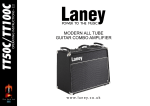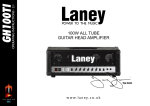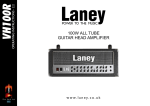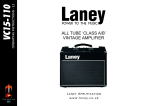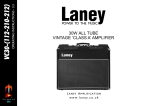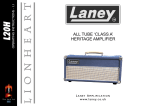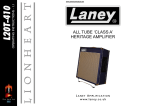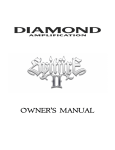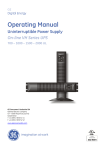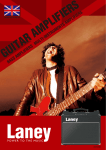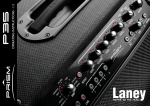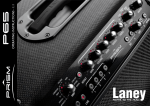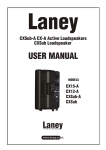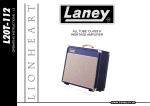Download Laney Amplification TT50H Musical Instrument Amplifier User Manual
Transcript
OPERATING INSTRUCTIONS - 2.2 TT50H/ TT100H Laney POWER TO THE MUSIC MODERN ALL TUBE GUITAR HEAD AMPLIFIER w w w. l a n e y. c o . u k TT50H/TT100H IMPORTANT SAFETY INSTRUCTIONS WARNING: When using electric products, basic cautions should always be followed, including the following. 1. Read all safety and operating instructions before using this product 2. The product should be powered by a three pin `grounded (or earthed) plug connected to a power socket with a grounded earth outlet. 3. All safety and operating instructions should be retained for future reference 4. Obey all cautions in the Operating instructions and on the back of the unit 5. All operating instructions should be followed 6. This product should not be used near water, i.e. a bathtub, sink, swimming pool, wet basement, etc. 7. This product should be located so that its position does not interfere with its proper ventilation. It should not be placed flat against a wall or placed in a built up enclosure that will impede the flow of cooling air. 8. This product should not be placed near a source of heat such as stove, radiator, or another heat producing amplifier. 9. Connect only to a power supply of the type marker on the unit adjacent to the power supply cord. 10. Never break off the ground pin on a power supply cord. 11. Power supply cords should always be handled carefully. Never walk or place equipment on power supply cords. Periodically check cords for cuts or signs of stress, especially at the plug and the point where the chord exits the unit. 12. The power supply cord should be unplugged when the unit is to be unused for long periods of time. 13. If this product is to be mounted in an equipment rack, rear support should be provided. 14. The user should allow easy access to any mains plug, mains coupler and mains switch used in conjunction with this unit thus making it readily operable. 15. Metal parts can be cleaned with a damp cloth. The vinyl covering used on some units can be cleaned with a damp cloth or ammonia based household cleaner if necessary. Disconnect the unit from the power supply before cleaning. 16. Care should be taken so that objects do not fall and liquids are not spilled into the unit through any ventilation holes or openings. On no account place drinks on the unit. 17. A qualified service technician should check the unit if: ! The power cord has been damaged ! Anything has fallen or spilled into the unit ! The unit does not appear to operate correctly ! The unit has been dropped or the enclosure damaged. 18. The user should not attempt to service the equipment. All service work is done by a qualified service technician. 19. Exposure to extremely high noise levels may cause a permanent hearing gloss. Individuals vary considerably in susceptibility to noise induced hearing loss, but nearly everyone will lose some hearing if exposed to sufficiently intense noise for a sufficient time. The U.S. Government's Occupational Safety and Health Administration (OSHA) has specified the following permissible noise level exposure. Duration Per Day In Hours Sound Level dBA, slow response 8 90 6 92 4 95 3 97 2 100 1½ 102 1 105 ½ 110 ¼ or less 115 According to OSHA, any exposure in excess of the above permissible limits could result in some hearing loss. Ear plugs or protectors in the ear canals or over the ears must be worn when operating this amplification system in order to prevent a permanent hearing loss if exposure exceeds the limits set forth above. To ensure against potentially dangerous exposure to high sound pressure levels it is recommended that all persons exposed to equipment capable of producing high sound pressure levels such as this amplification system be protected by hearing protectors while this unit is in operation. SAVE THESE INSTRUCTIONS Page 2/24 TT50H/ TT100H Intended to alert the user to the presence of uninsulated ‘Dangerous Voltage’ within the products enclosure that may be sufficient to constitute a risk of electrical shock to persons. Este simbolo tiene el proposito de alertar al usuario de la presencia de ‘(voltaje) peligroso’ que no tiene aislamiento dentro de la caja del producto que puede tener una magnitud suficiente como para constituir riesgo de corrientazo. Intended to alert the user of the presence of important operating and maintenance (Servicing) instructions in the literature accompanying the product. Este simbolo tiene el proposito de la alertar al usario de la presencis de instrucccones importantes sobre la operacion y mantenimiento en la literatura que viene conel producto. CAUTION: Risk of electrical shock - DO NOT OPEN. PRECAUCION: Riesgo de corrientazo - no abra CAUTION: To reduce the risk of electrical shock, do NOT remove the cover. No user serviceable parts inside. Refer servicing to qualified personnel. PRECAUCION: Para disminuir el risego de carrientazo, no abra la cubierta. No hay piezas adentro que el pueda reparar. Deje todo mantenimiento a los tecnicos calificadod. WARNING: To prevent electrical shock or fire hazard, do not expose this appliance to rain or moisture. Before using this appliance please read the operating instructions for further warnings. ADVERTENCIA: Para evitar corrientazos o peligro de incendio, no deja expuesto a la lluvia o humedad este aparato Antes de usar este aparato, lea mas advertcias en la guia de operacion. Ce symbole est utililise pur indiquer a l’utilisateur de ce produit de tension non-isolee dangereuse pouvant etre d’intensite suffisante pour constituer un risque de choc electrique Dieses Symbol soll den Anwender vor unsolierten gefahrlichen Spannungen innerhalb des Gehauses warnen, die von Ausrichender Starke sind, um einen elektrischen Schlag verursachen zu konnen. Ce symbole est utilise pour indiquer a l’utilisanter qu’il ou qu’elle trouvera d’importantes instrucions sur l’utilisation et l’entrerien (service) de l’appareil dans la litterature accompagnant le produit. Dieses Symbol soll den Benutzer auf wichtige Instruktionen in der Bedienungsanleitung aufmerksam machen, die Handhabung und Wartung des Produkts betreffen. ATTENTION: Risques de choc electrique - NE PAS OUVIRIR ATTENTION: Afin de reduire le risque de choc electrique, ne pas enlever le couvercle. II ne se trouve a l’interieur aucune piece pouvant etre reparee par l’utilisateur. Confier l’entretien a un personnel qualifie. ADVERTISSEMENT: Afin de prevenir les risques de decharge electrique ou de feu, n’exposez pas cet appareil a la pluie ou a l’humidite. Avant d’utiliser cet appareil, lisez les advertissments supplentaires situes dans le guide. VORSICHT: Risiko - Elektrischer Schlag! Nicht offen! VORSICHT: Um das Risiko eines elektrischen Schlages zu vermeiden, nicht die Abdeckung enfernen. Es befinden sich keine Teile darin, die vom Anwender repariert werden Konnten. Reparaturen nur von qualifiziertem Fachpersonal durchfuhren lassen. ACHTUNG: Um einen elektrischen Schalg oder Feuergefahr zu vermeiden, sollte dieses Gerat nicht dem Regen oder Feuchtigkeit ausgesetzt werden. Vor Inbetriebnahme unbedingt die Bedienungsanleitung lesen. Page 3/24 TT50H/TT100H Laney OPERATING INSTRUCTIONS BEFORE SWITCHING ON After unpacking your amplifier check that it is factory fitted with a three pin 'grounded' (or earthed) plug. Before plugging into the power supply ensure you are connecting to a grounded earth outlet. If you should wish to change the factory fitted plug yourself, ensure that the wiring convention applicable to the country where the amplifier is to be used is strictly conformed to. As an example in the United Kingdom the cable colour code for connections are as follows. EARTH OR GROUND - GREEN/YELLOW NEUTRAL - BLUE LIVE - BROWN NOTE This manual has been written for easy access of information. The front and rear panels are graphically illustrated, with each control and feature numbered. For a description of the function of each control feature, simply check the number with the explanations adjacent to each panel. Your Laney amplifier has undergone a thorough two stage, pre-delivery inspection, involving actual play testing. When you first receive your Laney guitar amplifier, follow these simple procedures: (i) Ensure that the amplifier is the correct voltage for the country it is to be used in. ii) Connect your instrument with a high quality shielded instrument cable. You have probably spent considerable money on your amplifier and guitar - don’t use poor quality cable it won’t do your gear justice. Please retain your original carton and packaging so in the unlikely event that some time in the future your amplifier should require servicing you will be able to return it to your dealer securely packed. Care of your Laney amplifier will prolong it's life.....and yours! Page 4/24 TT50H/ TT100H Laney OPERATING INSTRUCTIONS Dear Player, Thank you very much for purchasing your new Laney product and becoming part of the worldwide Laney family. Each and every Laney unit is designed and built with the utmost attention to care and detail, so I trust yours will give you many years of enjoyment. Laney products have a heritage which stretches back to 1967 when I first began building valve amplifiers in my parent’s garage. Since then we have moved on from strength to strength developing an extensive range of guitar, bass, public address and keyboard amplification products along with a list of Laney endorsees that includes some of the world’s most famous and respected musicians. At the same time we believe we have not lost sight of the reason Laney was founded in the first place - a dedication to building great sounding amplification for working musicians. Warm Regards, Lyndon Laney CEO INTRODUCTION The Dark Art: In an age where guitar players have developed an unhealthy fascination with pre-amp distortion, the fabled sound of a tube power amp being pushed hard has almost passed into history. Until now that is! The TT50H and TT100H are modern versatile tube head amplifiers. They feature three discrete midi switchable preamp channels, each with its own EQ section; twin midi switchable master volumes; Independant reverb level controls for each channel; flexible FX loop with variable wet/dry mix control, giving you an unprecedented level of flexibility. You can now go from a super clean shimmer; to a warm crunch; to a full on lead tone, as simply as stepping on a switch - which is included with the amp (FS6). The hand wired output stage is built to deliver: 50W for the TT50H and 100W for the TT100H, the harder you drive it, the better it sounds. The TT amplifiers are designed to be used with the TT412A and TT412S extension cabinets - to enhance the amplifiers huge tonal range and produce stunning tone at any volume. The TT amplifiers offer total flexibility - flexibility of tone and flexibility of use. Your TT should give you years of trouble-free amplification, however please take time to read this manual and familiarise yourself with the controls as it will allow you to get the best from your amplifier. We hope you enjoy using your TT as much as we enjoyed designing and making it. Best wishes from all at Laney Page 5/24 TT50H/TT100H Laney 30 29 28 OPERATING INSTRUCTIONS 27 26 1 PRESENCE 0 MAINS FX MIX 25 24 AMP DAMPING MUTE TIGHT REVERB STANDBY 3 TT100H VOLUME 2 VOLUME 1 2 8 7 REVERB TREBLE 6 5 8 7 6 5 8 MIDDLE BASS REVERB TREBLE MIDDLE BASS REVERB BOOST BRIGHT 7 6 TREBLE MIDDLE BRIGHT 23 22 21 14 9 2 FRONT PANEL CONTROLS 3 XPAND MODERN DRIVE MASTER 16 20 19 18 17 15 2 MODERN DRIVE MASTER 11 12 13 BASS INPUT 1 CHANNEL 5 10 1 BRIGHT VOLUME 3 4 1 INPUT: Single jack input for connecting your instrument. Only use good quality guitar cable. CHANNEL 1 SWITCH: Press in to activate Channel 1, the led will illuminate when active. Channel 1 is designed to give the crispest clean tones around. This switch is footswitchable and midi controllable, for more information on midi see the midi section later in the manual. VOLUME: Sets the level of the clean channel channel pre-amplifier. BRIGHT: Adds brightness and life to the treble frequencies of your guitar. This switch has more effect at low clean volume settings. Use in conjunction with the treble control (7) for optimum performance. BASS, MIDDLE,TREBLE: These are a traditional set of passive tone controls. Passive controls have the advantage of always sounding musical at any of their settings mainly due to their unique interactive nature. This gives players a more natural set of tools to create their ideal sound. (Try them all set at midway (5) as a good starting point) REVERB: Controls the amount of signal sent to the onboard reverb from each channel. The reverb in the TT is a legendary Sound Enhancements aka ‘Accutronics Reverb’. The only choice for that authentic reverb sound. Use in conjunction with the overall reverb level control in the master section (26) to set the amount of reverb you actually hear. CHANNEL 2 SWITCH: Press in to activate Channel 2, the led will illuminate when active. Channel 2 is designed to be completely flexible giving punchy cleans, smooth blues and hard rock tones. This switch is footswitchable and midi controllable, Page 6/24 Laney OPERATING INSTRUCTIONS FRONT PANEL CONTROLS - continued for more information on midi see the midi section later in the manual. DRIVE: Sets the level of tube preamplifier gain or how dirty your sound is for the drive channel - Channel 2. This control should be used in conjunction with the master (11) Setting low levels of drive with high levels of master will give a clean preamplifier sound, setting a medium gain level and medium Volume will give a nice crisp bluesy lead tone, while setting a high level on the drive control and a low setting on the master will give you a punchy hard rock lead tone. Having set the drive and master controls to your desired sound try backing off your guitar volume and tone controls for lots of other cool sounds. Good tube amplifiers have the unique ability to produce a wide range of sounds by using only your guitar controls, playing weight and style. MASTER: Sets the overall ‘loudness’ of channel 2. It is useful to experiment with the drive and master controls. If you want a very open, warm and semi overdriven sound try reducing the amount of drive (10) and increasing the master. BRIGHT: Adds edge and picking emphasise to you sound. This control has more effect at lower drive (10) settings. MODERN: The modern switch applies a degree of compression to the signal, providing massive smooth sustain. CHANNEL 3 SWITCH: Press in to activate Channel 3, the led will illuminate when active. Channel 3 is designed for full on stack style distortion. This switch is footswitchable and midi controllable, for more information on midi see the midi section later in the manual. DRIVE: Sets the level of tube preamplifier gain or how dirty your sound is for the lead channel - Channel 3. This control should be used in conjunction with the master (16) Setting low levels of drive with high levels of master will give a nice crisp bluesy lead tone, setting a medium level on the drive control and a medium setting on the master will give you a punchy hard rock lead tone while setting the drive control to maximum with a low setting on the master will result in a full on metal lead tone. Having set the drive and master controls to your desired sound try backing off your guitar volume and tone controls for lots of other cool sounds. Good tube amplifiers have the unique ability to produce a wide range of sounds by using only your guitar controls, playing weight and style. MASTER: Sets the overall ‘loudness’ of channel 3. It is useful to experiment with the gain and volume controls. If you want a very open, warm and semi overdriven sound try reducing the amount of drive (15) and increasing the master. Page 7/24 Laney OPERATING INSTRUCTIONS FRONT PANEL CONTROLS - continued BRIGHT: Adds edge and picking emphasise to you sound. This control has more effect at lower drive (10) settings. MODERN: The modern switch applies a degree of compression to the signal, providing massive smooth sustain. XPAND: At high gain and volume settings the natural tendancy for a tube amplifier is to compress, this has the effect of limiting the dynamic range of the note. The Xpand switch reduces the level of compression and allows more dynamic freedom for the note should you require it. If you are not playing at high gain and volume settings then the Xpand switch can also be used to get some interesting effect at low volume levels too. At low levels the Xpand switch functions as a mini gate and some interesting volume swell type effects are achievable. BOOST: Switches in an extra tube drive stage for even more gain to play around with for those who just can’t get enough. VOLUME 1: Sets the overall listening level of the amplifier, Crank the Volume up to drive the output tubes harder. Having set your channel controls to your desired sound try backing off your guitar volume and tone controls for lots of other cool sounds. Good tube amplifiers have the unique ability to produce a wide range of sounds by using only your guitar controls, playing weight and style. If you want a very open, warm and semi overdriven sound try reducing the amount of preamp gain and increasing the volume. This reduces pre-amp gain but pushes the power amp section and makes it work harder giving you a very desirable level of power amp distortion which is a very pleasing “retro” style sound. VOLUME 2 SWITCH: Switches in the alternate master volume 2 level control (23). VOLUME 2: This can be used to give a volume boost to the amplifier irrespective of which channel is selected the the preamp. For instance if you are playing a clean passage and want to boost the volume for a solo section, simply set volume 2 higher than volume 1 and when the appropriate time comes just switch from volume 1 to volume 2 via the footswitch. DAMPING: Damping is the term applied to the interaction of an amplifier in response to its load - in this case the loudspeaker/s. The higher the damping factor the more the speaker is controlled in its response to an input. To the listener this is heard as a tighter more defined bottom end response. The damping control lets you experiment with two levels of damping factor in order to get the bass response you’re looking for. It is normal for this control to make a slicking sound when operated. MUTE: This mutes the output section of the amplifier and the line out socket. It does not affect the signal path through the Page 8/24 TT50H/TT100H Laney OPERATING INSTRUCTIONS FRONT PANEL CONTROLS - continued pre-amplifier, so sends to the fx loops and record out are maintained allowing signal levels to be monitored silently and allow silent recording via the record out. REVERB: Sets the overall master level of the reverb. Use in conjunction with the individual channel reverb send level controls. FX MIX: Determines the level of signal returned from the FX return socket. You can infinately vary the mix between 100% dry to 100% wet and any mix of the two inbetween. The main modes are: !With the FX Mix turned to zero, the FX loop is bypassed and so no signal appears from the FX return jack socket. !With the FX mix control set to 5, the effects loop operates as a side chain effects loop where 50% of the signal is returned from the effects return (wet) whilst the remaining 50% is the original dry signal. Use Side chain mode for FX units such as delays, flangers etc where a direct signal path is maintained internally to avoid loss of dynamics through the external FX processor. !With the FX mix control set to 10, the effects loop operates as an insert loop where 100% of the signal returned from the FX return (wet) and non of the original dry signal is routed to the power amplifier. Use this mode when the whole of the amplifier signal needs routing through any external processors such as graphic EQs etc. The individual level of each channel is controlled by the channel volumes. NOTE: When the FX loop is not in use, set the FX MIX to zero. If nothing is connected to the effects loop and the FX Mix control is set to 10, then NO SIGNAL WILL BE HEARD FROM THE AMPLIFIER! PRESENCE: An output stage tone control. This adjusts the high frequency response - it adjusts your sound from being dull to giving it edge / sounding sparkly. STANDBY: Use to enable/disable the high voltage DC to the valves. The heaters are left on to keep the tubes warm and ready to run. POWER: Main power switch for the unit. (Always switch off and disconnect the power cord when not in use) Note: TT100H fascia shown on page 6. TT50H fascia identical other than model number print. Page 9/24 TT50H/TT100H Laney 39 38 OPERATING INSTRUCTIONS 37 45 44 43 42 35 40 41 34 36 33 31 32 REAR PANEL CONTROLS POWER INLET SOCKET: Connect to your power source. Make sure the specified voltage is correct for your country! POWER FUSE: This is the main safety fuse for the unit. The fuse protects the AC power to the amplifier. USE ONLY THE CORRECT SIZE AND RATING OF FUSE AS SPECIFIED ON THE PANEL. If a fuse blows or fails and a replacement of the same size and rating is installed and it in turn blows, the amplifier has suffered a malfunction internally and needs immediate service from a qualified technician. DO NOT TRY USING A FUSE OF HIGHER RATING. Using a fuse that is too large in current rating may cause serious, irreparable damage to the amplifier and presents a serious fire hazard. The mains fuse ratings are detailed in the specs section at the rear of this manual HT FUSE: This fuse protects the DC power to the tubes within the amplifier. USE ONLY THE CORRECT SIZE AND RATING FUSE AS SPECIFIED ON THE PANEL. If a fuse blows or fails and a replacement of the same size and rating is installed and it in turn blows, the amplifier has suffered a malfunction, at this point check the output tubes and replace faulty ones if required. Should tubes not be the problem the amplifier should be checked out by a qualified technician. Do not try using a fuse of greater value. Using a fuse that is too large in current rating may cause serious, irreparable damage to the amplifier. Fuses are designed to protect, do not take chances. LINE OUT: Provides a line level output taken immediately prior to the power stage for connection to other line level equipment such as a mixing desk/other sound reinforcement or even another TT amplifier via the FX return. LOUDSPEAKER SOCKETS: These dual ¼” (6.3mm) jack sockets should be used to connect your loudspeaker cabinet/s. Make sure the impedance selector switch is in the correct position for the total cabinet impedance connected. Failing to do so Page 10/24 TT50H/TT100H Laney OPERATING INSTRUCTIONS REAR PANEL CONTROLS - CONTINUED will result in masmatched impedance and will reduce the amplifiers performance and in some cases may cause damage to the amplifier.You may connect 1*4ohm, 1*8ohm, 2*8ohm, 2*16ohm cabinets to these sockets. Do not use at the same time as the 16 ohm socket. 16 OHM SOCKET: Use to connect a single 16 ohm cabinet. Do not use at the same time as the 4-8 ohm sockets. LOUDSPEAKER EXAMPLES: 4 ohm 8 ohm 8 ohm 8 ohm 16 ohm 16 ohm 16 ohm RECORD OUT: Use to connect to your chosen recording device. This socket will emulate the sound of the output tube stage so you don’t lose that fantastic sound. Used in combination with the mute switch will enable silent recording. EFFECTS RETURN: Connect the output from your external effects to this socket. Use only good quality shielded cables. EFFECTS SEND: Connect the input of your external effects unit to this socket. Some Effects are better suited to being between the guitar and amplifer input - these are foot pedal types / distortion / wah wah pedals etc. Rack mount effects will work better in the FX loop on the amplifer rear. Stomp boxes are normally designed for small signals such as a guitar output whereas rack mount FX are designed for the higher signal level obtained from an FX send. Use only good quality shielded cables. FOOTSWITCH: This is a 15 pin dtype socket for connection of the dedicated Laney FS6 footswitch enclosed with the amplifier. The FS6 allows remote switching of Channel 1, Channel 2, Channel 3,Volume 1&2 and Reverb. Do not connect any other device to this socket. MIDI: See midi section on page 12. Note: TT100H rear shown on page 10. TT50H rear features identical other than print details. Page 11/24 TT50H/TT100H Laney OPERATING INSTRUCTIONS REAR PANEL CONTROLS - MIDI SECTION 45 44 43 42 41 The advantage of having midi in your guitar amplifier is that it allows your amplifier and external devices (like FX controllers) to talk with each other. At last you can press one button to select the amplifier channel, and choice of effects on multiple devices all at once. The following front panel switches generate, (and can be controlled) via midi program change messages:Channel 1, Channel 2, Channel 3,Volume1/Volume2 The Reverb state can be recalled via midi but does not generate any midi information. With these features it is possible to assign different effects to each channel and Volume1/Volume 2 state allowing mind bending amounts of flexibility. The amplifier achieves these features by storing the amplifier switch states at the last received midi program change. MIDI ADDRESS: These switches allow you to select the midi channel on which the amplifier will send and receive midi data on. The default setting of these switches are all set to zero; this is called omni mode, as it will respond to all midi data regardless of the channel. If you need to respond only to a certain midi channel then you may do so by changing the midi address as follows. Each switch has a value (1,2,4,8) If the switch is set down to ‘1’ then the switch is on otherwise it is off. Simply add the values of all the ‘on’ switches together to get you midi channel number. eg: Channel 7 = 4+2+1 set to 1 (on), 8 set to 0 (off) Channel 13 = 8+4+1 set to 1 (on), 2 set to 0 (off) STORE BUTTON: This button is used to save the amplifier state. The integral led will illuminate whenever the amplifier is receiving midi data, to store the amplifier state (at the last received midi program) simply press and hold this switch in for approx two seconds. The led will flash to indicate a successful store operation. The amplifier will store the states of the Channel,Volume and reverb at the last received midi program change. The next time the amplifier receives this midi program change via the midi in socket the amplifier will switch to the stored state. Note: The reverb can only be assigned via the FS6 as there is no front panel switch for this function. MIDI OUT: This is where the TT amplifier generates its midi information. It is a 7 pin DIN socket supporting phantom power* Connect to the midi in of an external midi equipped device. MIDI THRU: Midi thru is a daisy chain buffered output of the midi in information. It is a 7 pin DIN socket supporting Page 12/24 Laney OPERATING INSTRUCTIONS REAR PANEL CONTROLS - continued phantom power* Connect to the midi in of the next external midi equipped device in the chain if required. MIDI IN: The TT amplifier receives midi information here from external midi devices such as foot controllers or midi sequencers allowing the status of the amplifer to be switched via midi. It is a 7 pin DIN socket supporting phantom power* Connect to the midi out of an external midi equipped device. * 5 pin DIN leads may be used instead of 7 pin DIN leads but they do not support phantom power. Shown here is a simple midi setup. The TT amplifier acts as the master controller by switching the state of the ‘slave’ external FX processor. Whenever channel or volume Switches are changed the TT amplifier sends a program change to the FX processor. The sent Program changes are shown below: Channel 1 + Volume 1 = Program 0 Channel 1 + Volume 2 = Program 3 MIDI APPLICATIONS NOTE 1: TT AMPLIFIER AND EXTERNAL EFFECTS BOX Channel 2 + Volume 1 = Program 1 Channel 2 + Volume 2 = Program 4 Channel 3 + Volume 1 = Program 2 Channel 3 + volume 2 = Program 5 Input Midi In Output FX Return Midi Out Channel 1 + Volume 1 = Program 0 > Small Reverb Channel 1 + Volume 2 = Program 3 > Chorus Channel 2 + Volume 1 = Program 1 > Small Delay Channel 2 + Volume 2 = Program 4 > Small Multi Tap Delay Channel 3 + Volume 1 = Program 2 > Large Hall Reverb Channel 3 + Volume 2 = Program 5 > Long Multitap Delay FX Send You then need to midi map desired FX to the above program changes on your FX processor. This gives 3 channel sounds, each at 2 different volume levels each with different a FX combination. For example a useful setup could be shown below: FX Processor You get reverbs and chorus FX for your clean sound on channel 1, FS6 Footswitch you get delays for your rhythm sounds on channel 2 and you get reverbs and long multitap delays for your lead breaks /solos on Channel 3. Page 13/24 OPERATING INSTRUCTIONS MIDI APPLICATIONS NOTE 2: TT AMPLIFIER AND MIDI CONTROLLER In this configuration the TT amplifier is a slave device ,its setting being called up by the midi controller. This midi controller could be a device which purely generates midi information or a multi effects pedal board. To setup the amplifier you need to do the following:1. Select the required patch on your pedal board/midi controller 2. Select the Channel/Volume/Reverb switch setting on your TT amp. 3. Press and hold the Store button. (for about 2 seconds) 2. Connect the next cable from the TT amps Midi Thru to the next devices Midi In repeat step 2 until you get to the end of your chain of toys. Midi Thru Midi In FS6 Footswitch Midi Out 1. Daisy chain the Midi out to Midi in from the midi controller to the TT amp, as shown in application 2. Midi Out The next time your select that patch - the setting of the Channel/Volume/Reverb switches will be recalled. Repeat steps 1>3 for each of your favourite patches. So for all your favourite sounds, your pedal board can assign a TT amp state. The TT amplifier will respond to 127 different program changes. Some FX processors have separate midi pedal board controllers which they remotely phantom power. Your TT amplifier is compatible with this system as it passes phantom power from the Midi In socket to the Midi Thru socket. If you have quite a selection of midi effects toys you can combine the two applications. Useful recommendations in doing so are: FX Return Further Possibilities FX Send TT50H/TT100H Laney ....Midi Patch 1 .---,- Midi Controller Page 14 /24 TT50H/TT100H Laney OPERATING INSTRUCTIONS QUICK START SETTINGS - suggestions only! Experiment Crystal Clean Blues Clean Blues Lead Page 15/24 TT50H/TT100H Laney OPERATING INSTRUCTIONS QUICK START SETTINGS - continued Rock Rhythm Rock Lead Metal Page 16 /24 TT50H/TT100H Laney OPERATING INSTRUCTIONS USER SETTINGS - Storte your own cool sounds here Page 17/24 TT50H/TT100H Laney OPERATING INSTRUCTIONS TUBE AMPLIFIER SURVIVAL TIPS Tube amplifiers generally sound much warmer/sweeter than solid state transistor amplifiers but they also need a little more respect due to the fragile glass tubes themselves. The TT uses top quality tubes, six ECC83 preamp tubes, and a matched set of four EL34B-STR output tubes (two EL34B-STR’s on the TT50H) which should give you years of trouble free service, however like all tube amps; it is important to treat it with a certain amount of respect. " Take care when moving the amplifier. Tubes are fragile glass components, they can easily be damaged if thrown in and out of transit vans etc. " Make sure the impedance of your cabinets matches the setting on your amplifier. Improper impedance matching will result in reduced output power output and compromised sound at best and amplifier failure/premature tube failure at worst. " Allow the amplifier to warm up to room temperature before switching it on, The sudden thermal shock generated can crack the cold glass tube housing plus any moisture is bad news around high voltage electronics. " Allow the amplifier to cool down after playing before moving. Hot tubes are more suseptable to damage than cool ones. Use good quality loudspeaker leads, cheap leads are often not up to the job of handling the large requirements for loudspeakers and can often short out. Tube amps don't like running into a short circuit. A tubes life expectancy is based upon a number of factors which include operating temperature, how hard and how often it is played, vibration due to travel etc. Tubes should be changed in your amplifier If you notice any change in your amplifiers performance etc. They need not be changed at any regular interval. Typical problems with preamp tubes can be a crackley noise, hiss, hum and microphony. The preamp tubes can safely be changed with no action required if they fail or reduce in performance. Typical output tube problems can be blown HT fuse, sound lacking in punch, sound lacks extreme highs or lows and low level hum. The Output tubes can be replaced singularly if you replace them with the exact same type AND grade as factory fitted otherwise they should be replaced as a set. If the same type and grade are used then no rebiasing of the amplifier is required. See the diagram at the bottom left hand corner to see how to check the tube grade fitted. If you wish to use a different grade of tube then they should only ever be changed by a qualified service agent due to the grid bias voltage needing adjustment. Do not attempt to rebias your tube amplifier yourself, there are potentially dangerous voltages inside. Exact replacement preamp tubes and matched sets of output tubes are available from Laney via your dealer. To change a tube, switch off the unit and unplug from the mains supply. Wait for the tubes to cool down. Remove the protective grille held in place with four screws. You should now be able to access the chassis where the tubes are mounted. Preamp tubes are protected with a screen can, to remove; gently twist the screen can anti clockwise and then pull up. The tube can then be gently pulled out. Take care when pushing the new tube in to make sure the pins are all aligned properly Output tubes have a spring retainer which must be pushed downwards before the tube will come out. Page 18/24 TT50H/TT100H Laney OPERATING INSTRUCTIONS TUBE AMPLIFIER SURVIVAL TIPS - continued V6 V8 V5 V3 V7 V8 V7 V6 V4 V2 V5 V3 V1 TT50H Tube Layout TT100H Tube Layout V4 V10 EL34B Grade Number V1 V2 V3 V4 V5 V6 V7-10 V2 V1 V9 ECC83 ECC83 ECC83 ECC83 ECC83 ECC83 EL34B-STR (High Grade) (High Grade) (Standard) (Standard) (Standard) (Standard) 1st Gain Stage Channel 1 1st Gain Stage Channel 2 2nd Gain Stage Channel 2 1st Gain Stage Channel 3 2nd Gain Stage Channel 3 Power Driver Stage Output Tubes (MATCHED SET) Page 19/24 TT50H/TT100H Laney OPERATING INSTRUCTIONS TT SAMPLE SYSTEM 1 Input FX Controller Output Laney Power To The Music RB115 TT412A Model Power Rating 300W Program Serial Number: SAMPLE DESIGNED IN THE UK BY LANEY www.laney.co.uk Input Link 8 Ohms 16 Ohms General Notes Amplifier connection: In order to avoid damage, it is advisable to establish and follow a pattern for turning on and off your equipment. With all system parts connected, turn on source equipment, tape decks, cd players, mixers, effects processors etc. BEFORE turning on your guitar amplifier. Many products have large transient surges at turn on and off which can cause damage to your speakers. By turning on your guitar amplifier LAST and making sure its Volume controls are set to minimum any transients from other equipment will not reach your loudspeakers. Wait until all system parts have stabilised; usually a couple of seconds. Similarly when turning off your system always turn down the Volume controls on your guitar amplifier and then turn off its power before turning off other equipment. Cables: never use shielded or microphone cable for any speaker connections as this will not be substantial enough to handle the amplifier load and could cause damage to your amplifier system. Caution: These professional loudspeaker systems are capable of generating very high sound pressure levels. Use care with placement and operation to avoid exposure to excessive levels that can cause permanent hearing damage. (Refer to guidelines on page 2) Page 20/24 Servicing: The user should not attempt to service these products. Refer all servicing to qualified service personnel. TT50H/TT100H Laney OPERATING INSTRUCTIONS Midi Out TT SAMPLE SYSTEM 2 Input FX Controller Output Further Sound Reinforcement Laney Power To The Music RB115 TT412A Model Power Rating 300W Program Serial Number: SAMPLE DESIGNED IN THE UK BY LANEY Input Link 8 Ohms 16 Ohms Input Link 8 Ohms 16 Ohms www.laney.co.uk Laney Power To The Music RB115 TT412A Model Power Rating 300W Program Serial Number: SAMPLE DESIGNED IN THE UK BY LANEY www.laney.co.uk Midi Controller Page 21/24 TT50H/TT100H Laney OPERATING INSTRUCTIONS BLOCK DIAGRAM RECORD OUT CHANNEL1 EQ FX SEND CHANNEL2 INPUT DRIVE EQ FX RETURN MASTER VOLUME 1 OUTPUT STAGE FX MIX MASTER VOLUME CHANNEL SWITCHING MASTER VOLUME 2 CHANNEL3 DRIVE MUTE VOLUME/ BRIGHT EQ LINE OUT MASTER VOLUME REVERB RETURN PRESENCE MASTER REVERB NOTE: This product conforms to the requirements of the following European Regulations, Directives & Rules:CE Mark (93/68/EEC), Low Voltage (72/23/EEC), EMC (93/68/EEC), RoHS (EU2002/95/EC), WEEE (EU2002/96/EC) In order to reduce environmental damage, at the end of its useful life, this product must not be disposed of along with normal household waste to landfill sites. It must be taken to an approved recycling centre according to the recommendations of the WEEE (Waste Electrical and Electronic Equipment) directive applicable in your country. Page 22/24 VH1000 0RH TT50H/TT1 Laney OPERATING INSTRUCTIONS SPECIFICATIONS Supply Voltage Mains Fuse TT50H Mains Fuse TT100H HT Fuse Power Consumption Output Power Rating Loudspeaker Options Features ~100V, ~120V, ~220V, ~230V, ~240V 50/60Hz Factory Option (~220V>240V = T2A L 250V) (~100>120V = T5A L 250V) (~220V>240V = T3.15A L 250V) (~100>120V = T6.3A L 250V) TT100H = T500mA L TT50H = T1A L TT50H = 200W TT100H = 300W TT50H = 50W TT100H = 100W 1*4ohm, 1*8ohm, 2*8ohm, 1*16ohm, 2*16ohm Pure Class A/B Valve tone 4xEL34B-STR Power Tubes (Matched Set TAD) 6x12AX7 Preamp tubes (Premium TAD ECC83) Rugged construction Variable Mix FX Loop (Sidechain/Insert/Bypass, 600mV Nominal) Line Out (1.5V Nominal) Record Out (600mV Nominal) Xpand (Channel3) Modern (Channel 2+3) Boost (Channel 3 EQ 3* Passive Bass, Middle and Treble Bright Switch Presence Channel, Drive A, Drive B, Reverb 1MOhm/47pF TTT50C = 330*653*253 TT50C = 21.5Kg Footswitchable Input Impedance Size (H*W*D) Unit Weight (Separate EQ for all channels) (For all channels) (Laney FS6 footswitch included) TT100C = 330*653*253 TT100C = 25Kg Page 23/24 Laney POWER TO THE MUSIC METAL JAZZ BLUES ROCK AMPICONS ARE HERE TO HELP! LANEY AMPLIFICATION w w w. l a n e y. c o . u k In the interest of continued product development, Laney Reserves the right to amend product specification without prior notification.
























